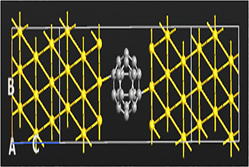Crossref Citations
This article has been cited by the following publications. This list is generated based on data provided by
Crossref.
Kaur, Milanpreet
Sawhney, Ravinder Singh
Engles, Derick
and
Kaur, Rupan Preet
2016.
Design of fullerene-based biomarker for detection of lead impurities.
ICT Express,
Vol. 2,
Issue. 4,
p.
159.
Nayyar, Payal
Kaur, Milanpreet
Vohra, Rajan
and
Sawhney, Ravinder Singh
2017.
To envisage charge transport attributes of doped Porphine devices.
Materials Research Express,
Vol. 4,
Issue. 8,
p.
085011.
Kaur, Milanpreet
Sawhney, Ravinder Singh
and
Engles, Derick
2017.
Electron transport in doped fullerene molecular junctions.
International Journal of Computational Materials Science and Engineering,
Vol. 06,
Issue. 02,
p.
1750019.
Kaur, Sukhdeep
Narang, Sukhleen Bindra
and
Randhawa, Deep Kamal Kaur
2017.
Influence of the pore shape and dimension on the enhancement of thermoelectric performance of graphene nanoribbons.
Journal of Materials Research,
Vol. 32,
Issue. 6,
p.
1149.
Kaur, Milanpreet
Sawhney, Ravinder Singh
and
Engles, Derick
2017.
Smallest fullerene-like clusters in two-probe device junctions: first principle study.
Molecular Physics,
Vol. 115,
Issue. 14,
p.
1678.
Kaur, Milanpreet
Sawhney, Ravinder Singh
and
Engles, Derick
2017.
Linear response formulism of a carbon nano-onion stringed to gold electrodes.
Applied Physics A,
Vol. 123,
Issue. 4,
Kaur, Milanpreet
Sawhney, Ravinder Singh
and
Engles, Derick
2017.
The DFT-NEGF scrutiny of doped fullerene junctions.
Journal of Molecular Modeling,
Vol. 23,
Issue. 8,
Kaur, Milanpreet
Sawhney, Ravinder Singh
and
Engles, Derick
2017.
Morphology pursuance in C20 fullerene molecular junction: ab initio implementation.
Journal of Micromechanics and Molecular Physics,
Vol. 02,
Issue. 02,
p.
1750007.
Kaur, Milanpreet
Sawhney, Ravinder Singh
and
Engles, Derick
2017.
Ab-initio molecular characterization of nonclassical fullerenes cluster using two probe approach.
Journal of Materials Research,
Vol. 32,
Issue. 2,
p.
414.
Kaur, Milanpreet
Sawhney, Ravinder Singh
and
Engles, Derick
2018.
Negative differential resistance observation in complex convoluted fullerene junctions.
Journal of Applied Physics,
Vol. 123,
Issue. 16,
Caliskan, Serkan
2018.
Spin resolved electronic transport through N@C20 fullerene molecule between Au electrodes: A first principles study.
Physica E: Low-dimensional Systems and Nanostructures,
Vol. 99,
Issue. ,
p.
43.
Vohra, Rajan
and
Sawhney, Ravinder Singh
2018.
Envisaging quantum transport phenomenon in a muddled base pair of DNA.
Pramana,
Vol. 90,
Issue. 5,
Kaur, Milanpreet
Sawhney, Ravinder Singh
and
Engles, Derick
2018.
Ab initio scrutiny of endohedral C20 fullerenes implanted in between gold electrodes.
Journal of Molecular Modeling,
Vol. 24,
Issue. 4,
Caliskan, Serkan
2019.
A first principles study on spin resolved electronic properties of X@C70 (X = N, B) endohedral fullerene based molecular devices.
Physica E: Low-dimensional Systems and Nanostructures,
Vol. 108,
Issue. ,
p.
83.
Khalatbari, H.
Vishkayi, S. Izadi
and
Soleimani, H. Rahimpour
2020.
The impact of Fe atom on the spin-filter and spin thermoelectric properties of Au-Fe@C20-Au monomer and dimer systems.
Scientific Reports,
Vol. 10,
Issue. 1,
Sarkar, Sudip
Paul, Satadal
and
Misra, Anirban
2020.
Spin-polarized electrical transport in transition metal encapsulated C20 fullerenes: A theoretical account.
Chemical Physics Impact,
Vol. 1,
Issue. ,
p.
100002.
Karimianfard, Ali
Oftadeh, Mohsen
and
Mohajeri, Afshan
2021.
Various Electrode Configurations Effect on the Electronic Transport of CNT/Benzene/CNT System by DFT-NEGF Method.
Iranian Journal of Science and Technology, Transactions A: Science,
Vol. 45,
Issue. 5,
p.
1657.
Zhao, Ying-Qin
Lan, Jun-Qing
Hu, Cui-E
Mu, Yi
and
Chen, Xiang-Rong
2021.
Electron Transport of the Nanojunctions of (BN)n (n = 1–4) Linear Chains: A First-Principles Study.
ACS Omega,
Vol. 6,
Issue. 24,
p.
15727.
Caliskan, Serkan
2021.
Structural, Electronic and Adsorption Characteristics of Transition Metal doped TM@C70 Endohedral Fullerenes.
Journal of Cluster Science,
Vol. 32,
Issue. 1,
p.
77.
Kaur, Jupinder
and
Kumar, Ravinder
2021.
Borospherene-based biomarker for DNA sequencing: a DFT study.
Journal of Computational Electronics,
Vol. 20,
Issue. 5,
p.
1916.




